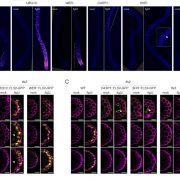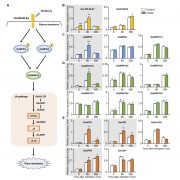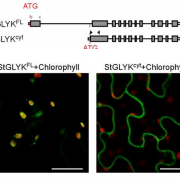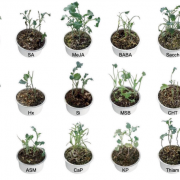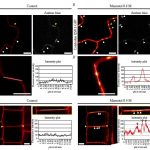Reconstituting an NLR cell death branch (Plant Cell)
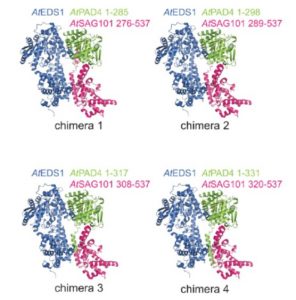 Arabidopsis genetics has identified numerous genes required for pathogen perception and defense response activation. Some of these genes are functionally conserved across plants and others are not. Toll-Interleukin1-Receptor (TIR)-domain NLRs (TNLs) are immune receptors that function upstream of EDS1 (enhanced disease susceptibility) genes. Lapin, Kovacova, Sun, et al. set out to investigate the phylogeny and function of EDS1 family members; these include EDS1, PAD4 and SAG101. In Arabidopsis, previous studies showed that AtEDS1 functions in a heterodimer with one of its partners, AtPAD4, to transcriptionally mobilize anti-microbial defense pathways. In this new work, the authors show that AtEDS1 and AtSAG101, together with AtNRG1, promote cell death in Arabidopsis. Previous work found that SAG101 is missing from monocot genomes, and here the authors also found it missing from the genomes of several eudicots. Through domain swapping and functional assays in Nicotiana benthamiana, the authors identified key domains required for heterodimerization and function in these related proteins. The authors conclude, “TNL-triggered cell death and pathogen growth restriction are determined by distinctive features of EDS1-SAG101 and EDS1-PAD4 complexes and that these signaling machineries coevolved with other components within plant species or clades to regulate downstream pathways in TNL immunity.” (Summary by Mary Williams) Plant Cell 10.1105/tpc.19.00118
Arabidopsis genetics has identified numerous genes required for pathogen perception and defense response activation. Some of these genes are functionally conserved across plants and others are not. Toll-Interleukin1-Receptor (TIR)-domain NLRs (TNLs) are immune receptors that function upstream of EDS1 (enhanced disease susceptibility) genes. Lapin, Kovacova, Sun, et al. set out to investigate the phylogeny and function of EDS1 family members; these include EDS1, PAD4 and SAG101. In Arabidopsis, previous studies showed that AtEDS1 functions in a heterodimer with one of its partners, AtPAD4, to transcriptionally mobilize anti-microbial defense pathways. In this new work, the authors show that AtEDS1 and AtSAG101, together with AtNRG1, promote cell death in Arabidopsis. Previous work found that SAG101 is missing from monocot genomes, and here the authors also found it missing from the genomes of several eudicots. Through domain swapping and functional assays in Nicotiana benthamiana, the authors identified key domains required for heterodimerization and function in these related proteins. The authors conclude, “TNL-triggered cell death and pathogen growth restriction are determined by distinctive features of EDS1-SAG101 and EDS1-PAD4 complexes and that these signaling machineries coevolved with other components within plant species or clades to regulate downstream pathways in TNL immunity.” (Summary by Mary Williams) Plant Cell 10.1105/tpc.19.00118



